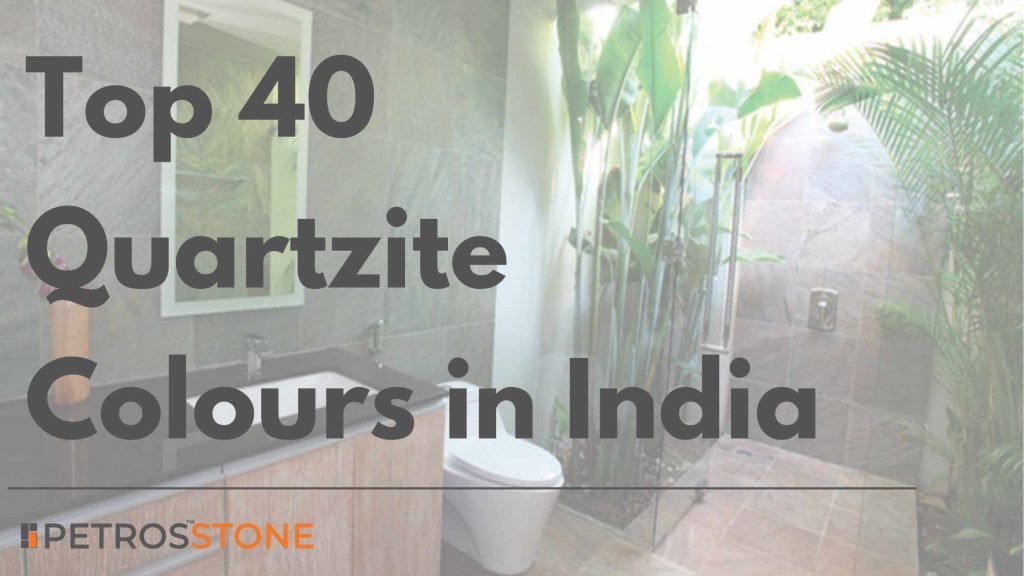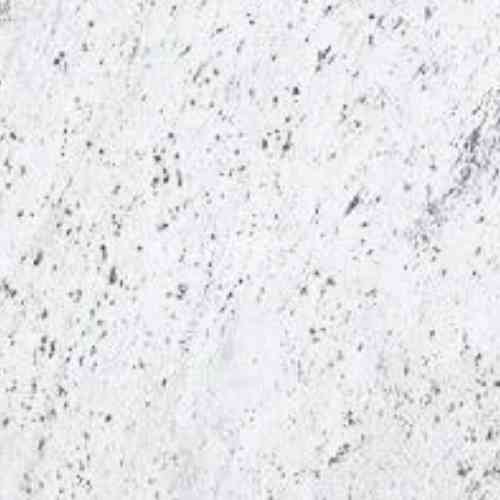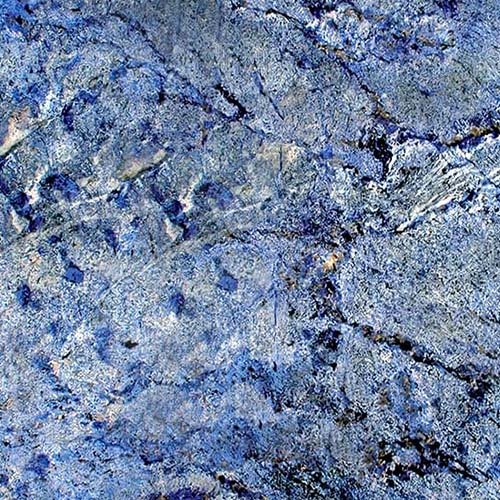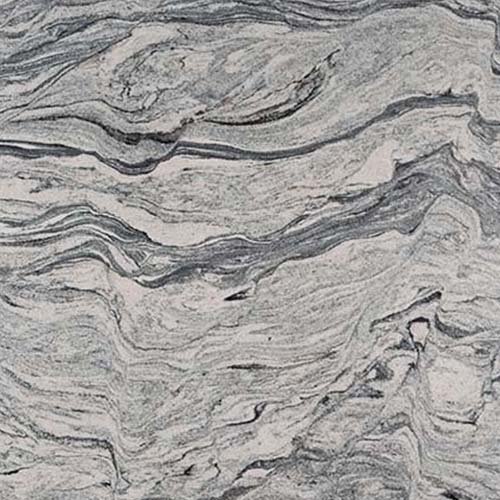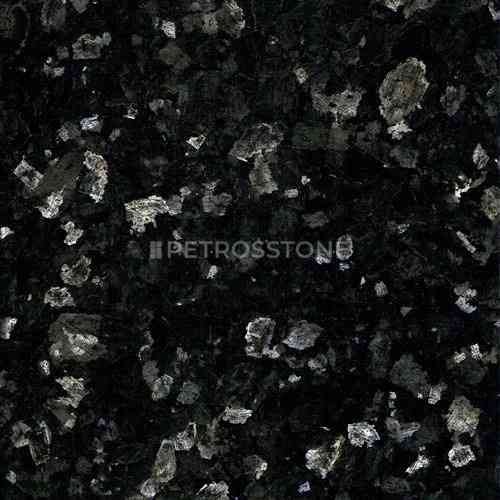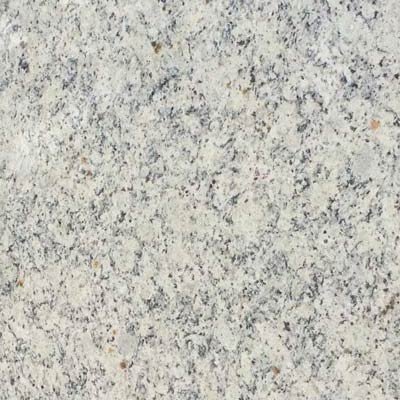
Quartzite has become one of the most sought-after natural stones in modern design, offering both strength and beauty. Formed through the metamorphosis of sandstone under immense heat and pressure, quartzite transforms into a dense, crystalline stone with striking veining and colors that rival marble while delivering durability comparable to granite.
When planning a project, however, quartzite’s visual appeal is only half the story. The size and thickness of slabs play a critical role in design, cost, installation, and long-term performance. Whether you’re installing a seamless kitchen island, a full-height backsplash, or a luxury hotel lobby wall, understanding standard slab sizes, helps in making practical decisions. Similarly, choosing between thicknesses ensures the right balance of aesthetics and structural integrity.
Standard Quartzite Slab Sizes
| Type of Slab | Size (inches) | Size (cm) | Approx. Area (sq. ft.) | Best Use Cases |
|---|---|---|---|---|
| Mini Slab | 31″ × 120″ | 80 × 305 cm | ~26 sq. ft. | Vanities, laundry counters, small bathrooms |
| Regular Slab | 60″ × 120″ | 145 × 305 cm | ~50 sq. ft. | Smaller kitchens, walls, bathroom counters |
| Jumbo Slab | 64″ × 126″ | 160 × 320 cm | ~56 sq. ft. | Medium to large kitchens, seamless backsplashes, islands |
| Super Jumbo | 79″ × 138″ | 200 × 350 cm | ~76 sq. ft. | Luxury islands, commercial walls, lobby claddings |
Standard Quartzite Slab Thickness
| Thickness | Inches | Best Applications | Support Requirement |
|---|---|---|---|
| 2 cm | ~0.79 in | Wall cladding, bathroom vanities, vertical installations | Needs plywood or substrate support for countertops |
| 3 cm | ~1.18 in | Kitchen countertops, islands, bar tops, heavy-use areas | No extra support required |
In this article, we break down everything you need to know about quartzite slab dimensions, thickness options, and physical properties so you can select the perfect fit for your project—whether it’s residential, commercial, or architectural.
- Quartzite Slab Sizing
- How to Choose the Right Quartzite Stone Slab Size?
- Advantages of Jumbo Quartzite Slabs (320 × 160 cm / 126″ × 63″)
- Advantages of Super Jumbo Quartzite Slabs (350 × 200 cm / 138″ × 79″)
- Why are Super Jumbo Quartzite Slabs More Expensive?
- Why Super Jumbo is Expensive to Install?
- Waste Reduction Strategies – Must Know
- General Waste Approximations
- Best Size for Calacatta Quartzite Slabs
- What is the Largest Size of a Quartzite Slab?
- Quartzite Slab Thickness Options
- Which Quartzite Slab Thickness is Best for You?
- Quartzite for Countertops & Backsplashes – Recommended Slab Size
- Recommended Size & Thickness by Application
- Standard Dimensions and Custom Cuts
- Custom Cutting and Edge Profiles
- Physical Properties of Quartzite
- FAQs
- Summary
- Key Takeaways
Quartzite Slab Sizing
Typically, size is the first factor of consideration when sourcing quartzite. Larger slabs will create a more pristine installation with fewer seams, while smaller slabs can create less waste in tighter areas.
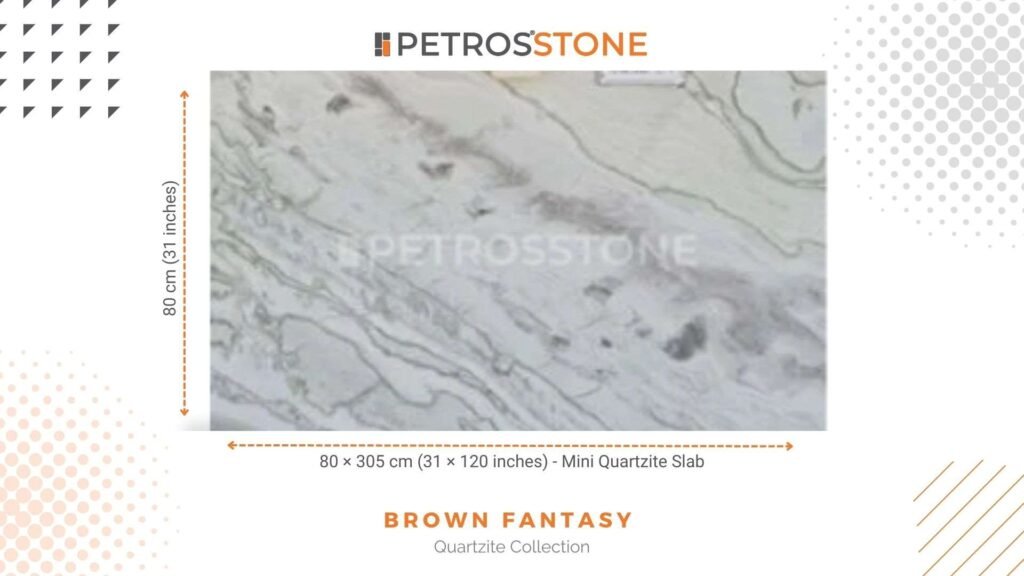
Mini Slabs
The average size for mini slabs is 31 × 120 inches. Since these slabs pick up less weight, they are easier to grip and install. As a result, these materials are often a preferable choice for bathroom vanities, backsplashes, or compact counters. They also happen to be the favored product of the fabricator, as they do not require the lifting equipment associated with heavier slabs.

Regular Slabs
Regular quartzite slabs, typically 60″ × 120″ (145 × 305 cm) and covering about 50 sq. ft., are the most common standard size. They’re ideal for smaller kitchens, bathroom counters, and wall applications, offering a balance of easy handling and versatile use. While not as expansive as jumbo slabs, they remain a practical and cost-efficient choice for many residential projects.
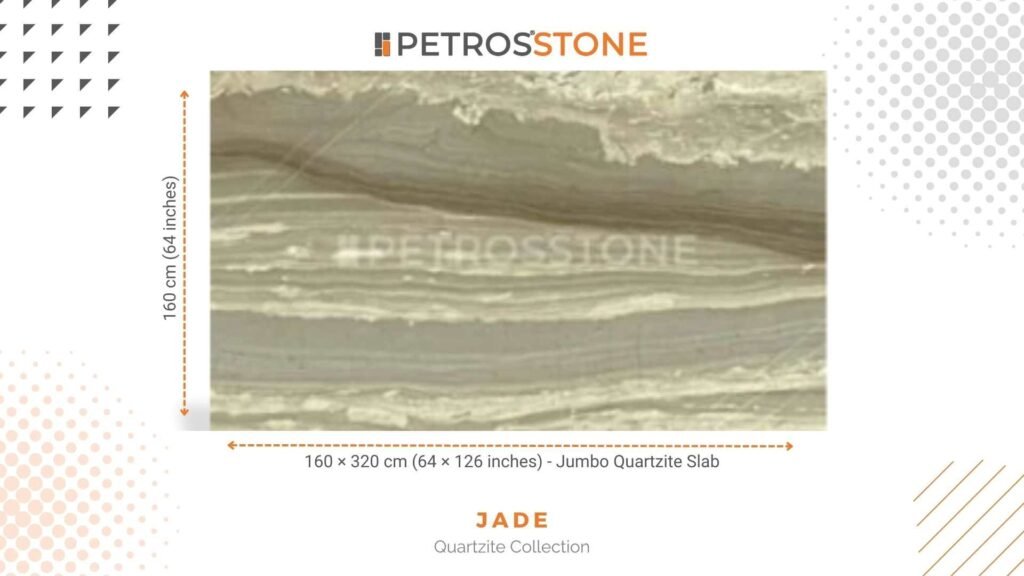
Jumbo Slabs
A common standard, jumbo slabs usually measure about 126 × 64 inches (10.5 × 5.25 ft.). They’re big enough for most kitchens, long islands, and feature walls. The larger surface area keeps seams to a minimum, letting the stone’s pattern flow naturally.
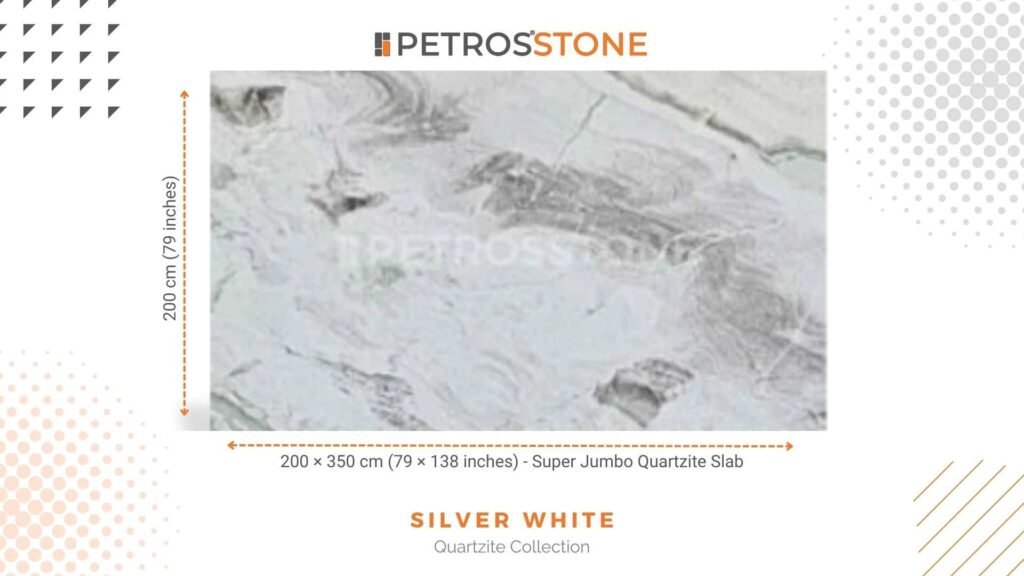
Super Jumbo Slabs
These are the giants, stretching to 138 × 79 inches (11.5 × 6.6 ft.) or beyond. Because of their size and weight, they demand careful handling. But for expansive open kitchens, oversized reception counters, or commercial projects, they provide an unmatched visual impact.
How to Choose the Right Quartzite Stone Slab Size?
Choosing the right size depends on your project scope, budget, and installation requirements.
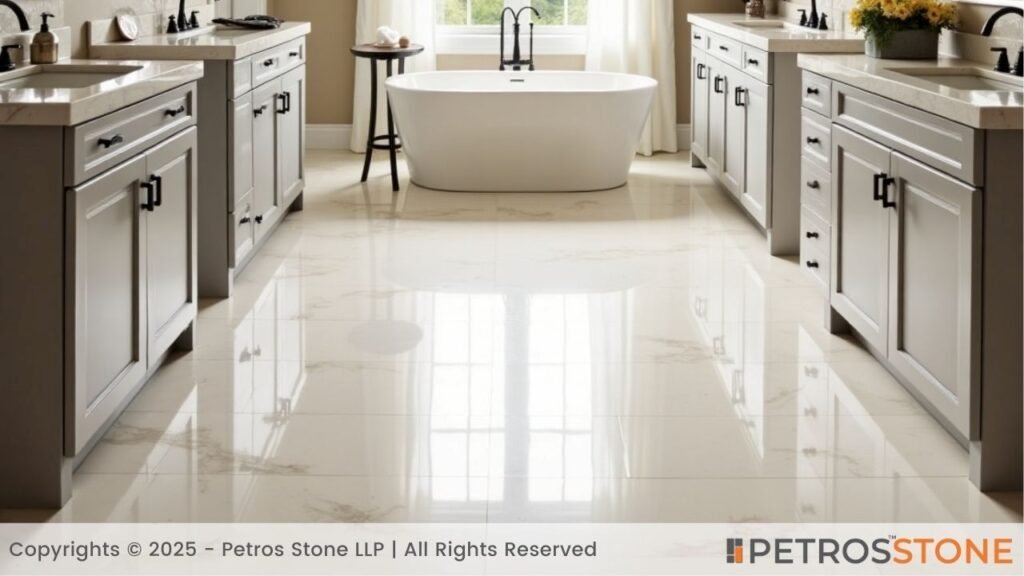
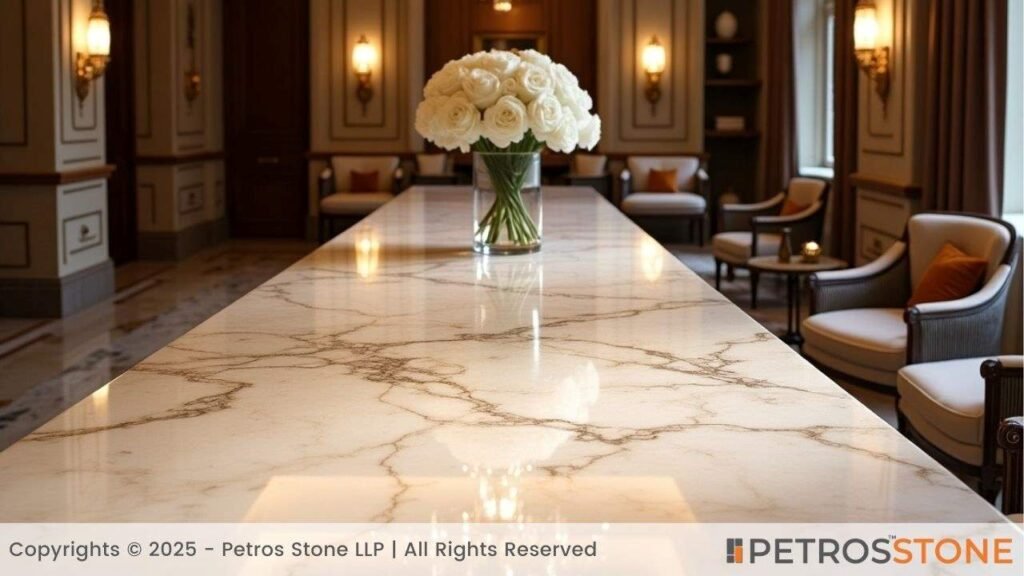
- For kitchens and bathrooms: Mini or regular slabs are often enough for vanities, shower walls, or smaller counters.
- For medium-sized kitchens and utility areas: Regular slabs provide a practical balance of coverage and handling ease.
- For large islands and open layouts: Jumbo slabs reduce the number of seams, creating a seamless visual flow.
- For commercial projects: Super jumbo slabs make sense for hotel lobbies, reception desks, and large-format walls where uninterrupted stone is desired.
The “right” size is the one that balances aesthetics, waste reduction, and practicality.
Jumbo Vs Super Jumbo – Which is the Best for You?
Both jumbo and super jumbo quartzite slabs have advantages, but the choice depends on application:
- Jumbo Slabs (126 × 63 in): Best for medium to large kitchens. They are easier to handle during transport and installation compared to super jumbo. They reduce seams in average-sized islands and provide excellent flexibility in cutting layouts.
- Super Jumbo Slabs (138 × 79 in): Perfect for large islands, full-height backsplashes, and expansive wall claddings. With a greater area, they eliminate visible seams in oversized designs. However, they are heavier, harder to move, and require advanced fabrication.
If you prioritize practicality and cost, jumbo slabs are a safe choice. For luxury projects where uninterrupted stone is a must, super jumbo slabs are worth the investment.
Advantages of Jumbo Quartzite Slabs (320 × 160 cm / 126″ × 63″)

1. Minimal Joints – Seamless, but Manageable
- Fewer seams than regular slabs.
- Natural vein flow appears continuous.
- Ideal balance between large coverage and easy handling.
2. Cost Considerations – More Affordable
- Generally 15–25% cheaper than super jumbo slabs.
- Reduces material waste for medium-sized projects.
- More economical for most kitchen and residential installations.
3. Thickness Options – Standard Choices
Quartzite jumbo slabs are usually available in:
- 2 cm (~0.79 in): Good for walls, vanities, and vertical use.
- 3 cm (~1.18 in): Preferred for countertops, islands, and heavy-use areas.
4. More Practical
- Large kitchen countertops.
- Kitchen islands.
- Bathroom vanities.
- Commercial bar tops.
- Floor-to-ceiling backsplashes.
Advantages of Super Jumbo Quartzite Slabs (350 × 200 cm / 138″ × 79″)

1. Seamless Elegance
- Minimal to no visible joints.
- Continuous, smooth surface for high-end appeal.
- Ideal for dramatic, uninterrupted patterns.
2. Design Versatility
- Expansive kitchen islands.
- Large-format countertops.
- Wall cladding in lobbies, hotels, and commercial projects.
- Bold architectural features.
3. Thickness Options
- 2 cm: For walls and vertical cladding.
- 3 cm: For countertops and heavy-use areas.
Why are Super Jumbo Quartzite Slabs More Expensive?
- Quarrying very large, flawless quartzite blocks is rare and challenging.
- Cutting, polishing, and transporting such sizes requires specialized equipment.
- Skilled handling and fabrication increase overall costs.
- On average, they are 15–25% more expensive than jumbo slabs.
Why Super Jumbo is Expensive to Install?
- Requires advanced fabrication skills.
- Professional handling and site-specific measurements are essential.
- Heavy transport logistics demand cranes or specialized equipment.
- Seam alignment and cutting are more complex due to vein patterns.
Waste Reduction Strategies – Must Know
1. Precise Measurement
- Use digital templates or CAD tools for exact sizing.
- Add 1–2 inches of overhang for cutting accuracy.
2. Optimal Slab Selection
- Use cut-list optimizer software to minimize waste.
- Select slab size that aligns best with your layout.
3. Kitchen Layout Planning
- Favor L-shaped or U-shaped layouts.
- Plan seam locations for natural vein flow.
- Integrate islands and countertops from the same slab where possible.
4. New Fabrication Techniques
- CAD and 3D templating ensure precision.
- Experienced fabricators can reduce waste through efficient cutting.
5. Super Jumbo Can Save Money
- Larger slabs may reduce the number of seams.
- Fewer seams often mean lower installation costs despite higher material price.
General Waste Approximations
| Kitchen Size | Recommended Slab Size | Estimated Waste |
|---|---|---|
| Small (50 sq. ft.) | 3100 × 1400 mm regular slab | 10–15% |
| Medium (100 sq. ft.) | 3200 × 1600 mm jumbo | 5–10% |
| Large (150+ sq. ft.) | Multiple slabs / super jumbo | 3–5% |
Best Size for Calacatta Quartzite Slabs
For quartzites with dramatic veining such as Calacatta Quartzite:
- Jumbo slabs work well for most islands and counters.
- Super jumbo slabs are ideal when vein continuity across an entire island or wall is essential.
- Avoid smaller slabs, as they may interrupt the natural vein flow.
What is the Largest Size of a Quartzite Slab?
The largest standard quartzite slab size currently available is 3500 × 2000 mm (138″ × 79″). Some suppliers may offer slightly larger or custom oversized cuts (up to 3600 × 2000 mm), but these are rare and expensive.
Quartzite Slab Thickness Options
Thickness is likely just as important as size. Thickness drives look and durability. A thicker edge will feel more professional and luxurious, while a thin profile will feel sleek and modern. In general, there are two standard thicknesses available, along with custom options for specialty projects.
Common Thicknesses (2 cm, 3 cm, Custom)
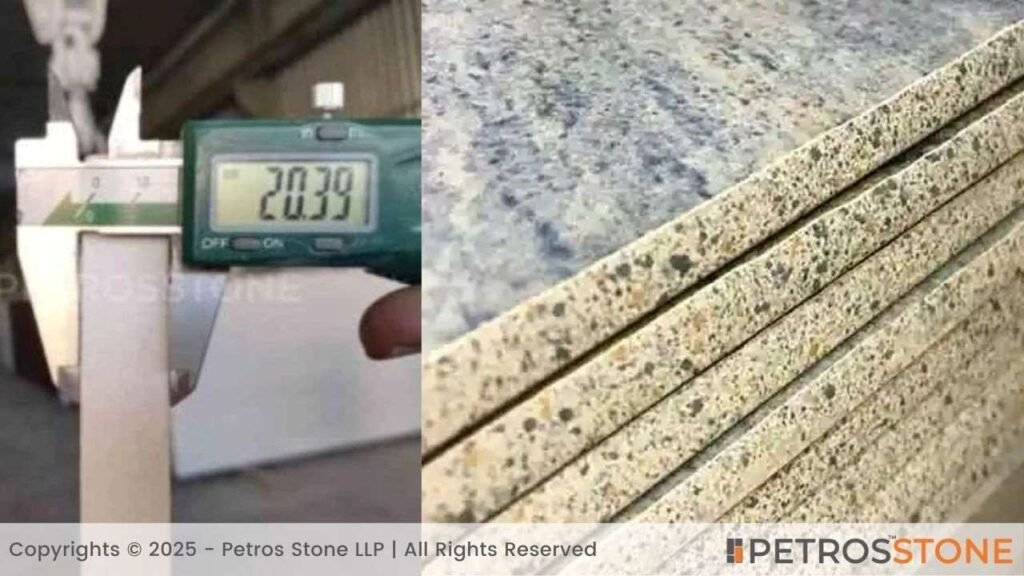
2 cm (¾ inch)
2 cm slabs are lighter and more transportable; they are commonly used in Europe and Asia, and they are probably a great option for vertically installed surfaces such as wall cladding, shower walls, or backsplashes. For countertops, they will typically need extra support (like plywood or laminate edges) to provide support for the material.
3 cm (1¼ inch)
This thickness of quartzite is the preferred choice for countertops throughout North America. As a thicker product, a 3 cm slab will support its weight and will inherently be less likely to crack or chip. Less susceptible to breaking than thinner slabs, you can build countertops at a normal pace, as there is typically no need for plywood backing. The additional mass also adds a more luxurious feel to your kitchen and bathroom.
Custom Thicknesses
Designers tend to push the envelope a little tighter than others. 4 cm slabs can be countertops or bars like nothing else. Ultra-thin (1.2 cm) slabs can be applied to lightweight applications like furniture panels or complex wall faces. Because these are not common sizes, special handling will be required, and generally at higher prices.
Advantages of Thicknesses
| Thickness | Best For | Key Benefits |
|---|---|---|
| 2 cm | Walls, vanities | Lightweight, easier to install, cost-effective. |
| 3 cm | Kitchens, islands | Superior strength, durability, no extra support needed. |
Which Quartzite Slab Thickness is Best for You?
- Kitchens: 3 cm thickness is the most recommended for strength and luxury.
- Floors & High-Traffic Areas: 2 cm works well, provided it’s installed with proper reinforcement.
- Walls & Decorative Surfaces: 2 cm or even lighter cuts make installation easier.
- Stairs: 3 cm thickness is best for durability and edge finishing.
Quartzite for Countertops & Backsplashes – Recommended Slab Size
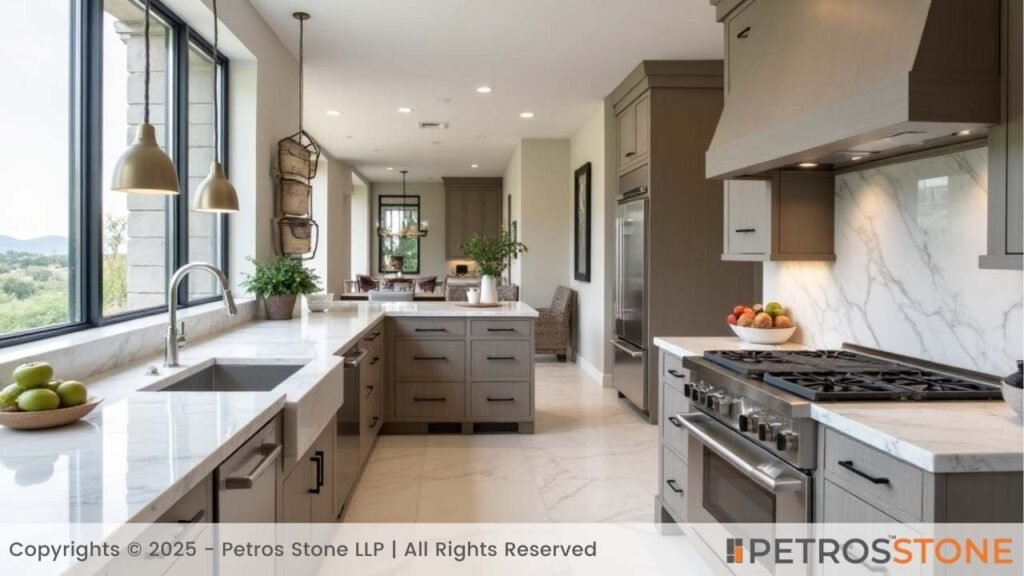
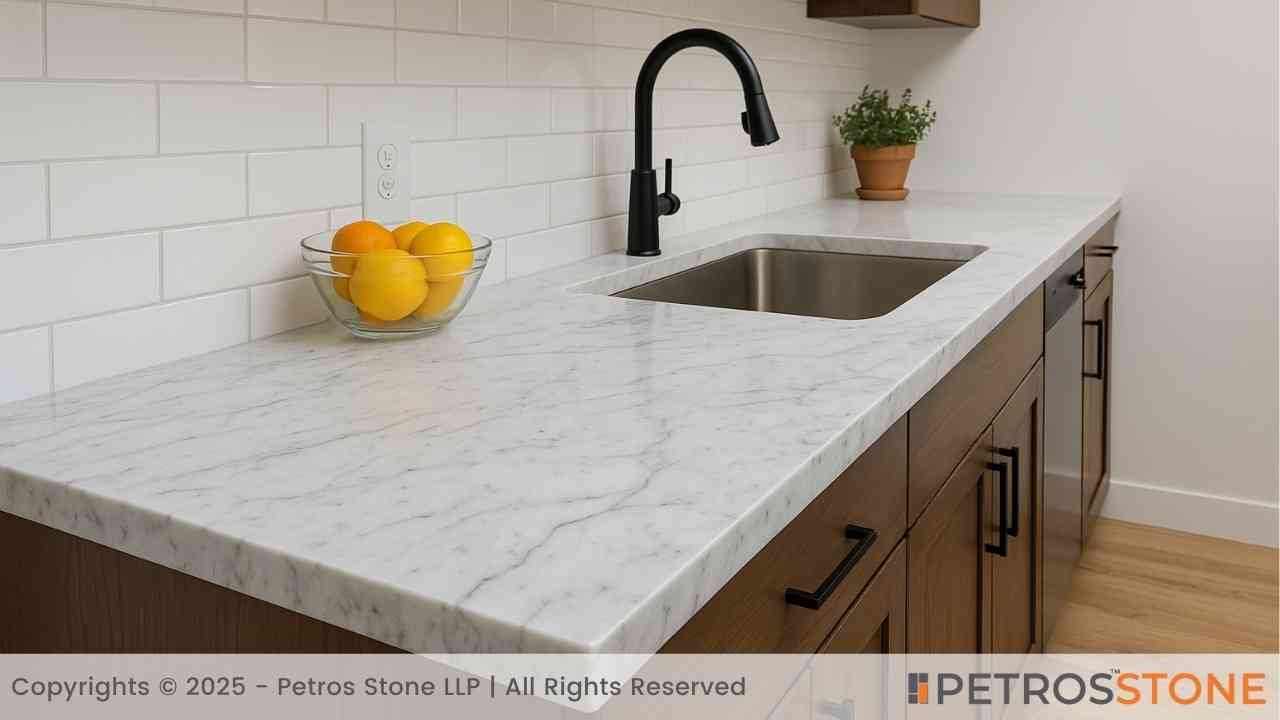
Because quartzite is denser and harder than granite, its visibility and durability are more evident in installation contexts, like kitchens and bathrooms. However, it is important to ensure that the ideal slab thickness and size are selected for both function and appearance.
For most kitchens, and likely yours, the preferred wall slab size is the jumbo slab (126 in x 63 in or about 10.5 ft x 5.25 ft). This size will cover the large countertop runs and kitchen islands with fewer seams. In addition to looking prettier, seams require cleaning and are often the greatest challenge with cleaning—these seams become even more critically positioned, often at the places with grout (that is more likely to stain) or resin-filled seams (not everyone wants food on a resin seam).
- Kitchen Islands: Oversized islands benefit from super jumbo slabs (up to 138 in x 80 in), as the stone is a single continuous piece, rather than breaking the stone with seams. One slab also provides its own attraction with dramatic veining or a stone aspect, like a piece of art.
- Standard Countertops: For your average L-shaped or galley kitchen, standard jumbo slabs provide sufficient length to create the primary runs of mostly flat solid surface, without meaningless cuts, etc.
- Small Spaces (bathrooms, bars, etc., or highly utilitarian purposes): Mini slabs are sufficient in smaller spaces and provide a less expensive alternative and limit waste as well.
Table – Recommended Quartzite Slab Sizes for Countertops & Backsplashes
| Application | Recommended Slab Size | Dimensions (inches) | Dimensions (cm) | Key Benefits |
|---|---|---|---|---|
| Kitchen Islands | Super Jumbo Slab | Up to 138″ × 80″ | 350 × 200 cm | Seamless, continuous surface for oversized islands; highlights dramatic veining. |
| Standard Countertops | Jumbo Slab | 126″ × 63″ | 320 × 160 cm | Covers long runs and L-shaped layouts with minimal seams. |
| Backsplashes / Walls | Jumbo Slab | 126″ × 63″ | 320 × 160 cm | Fewer grout/resin seams, easier cleaning, and elegant appearance. |
| Small Spaces (bath, bars, utility) | Mini Slab | ~96″ × 55″ | 244 × 140 cm | Budget-friendly, easier handling, limits waste in compact layouts. |
Rule of Thumb: Always choose the largest slab size your budget and layout allow. Fewer seams = cleaner look, easier maintenance, and stronger visual impact.
Best Thickness for Quartzite Countertops
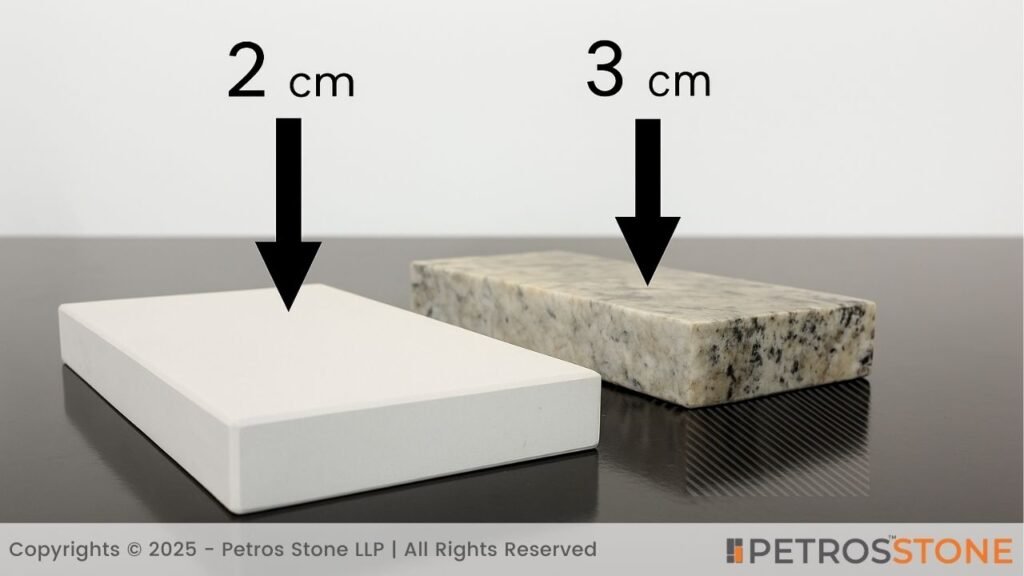

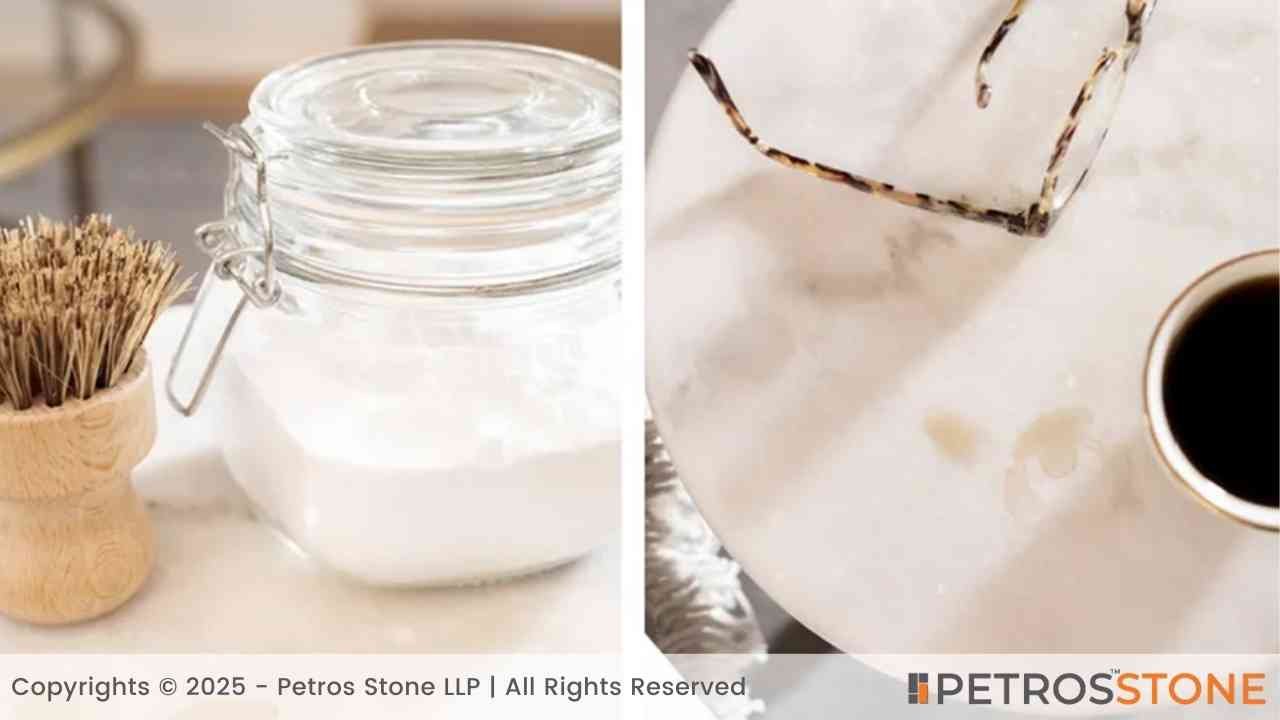
Countertops take a beating — hot pans, heavy skillets, and the occasional hammering or banging from kitchen appliances, etc.; therefore, the 3 cm quartzite slab is the most commonly referred to standard or code of measure (or a gold standard).
- 3 cm Thickness (1 ¼ inches): Solid enough for the protection of spanning cabinets without needing plywood support, less prone to cracking, and has a rich natural look.
- 2 cm Thickness (¾ inch): 2 cm thick slabs are common in the European style for countertops; however, they usually require some sort of plywood sub-top or additional bracing to be installed. In a kitchen, they can work beautifully, particularly if using laminated or mitered edges to provide the illusion of thickness.
- Custom (4 cm and above): For a statement or design piece. A 4 cm thick slab countertop will add a bold and dramatic touch to any kitchen, hotel bar, or corporate reception area; however, it will also increase weight and cost, and installation typically requires a fully professional team or individuals experienced in handling heavier specifications.
Quartzite Thickness for Backsplashes
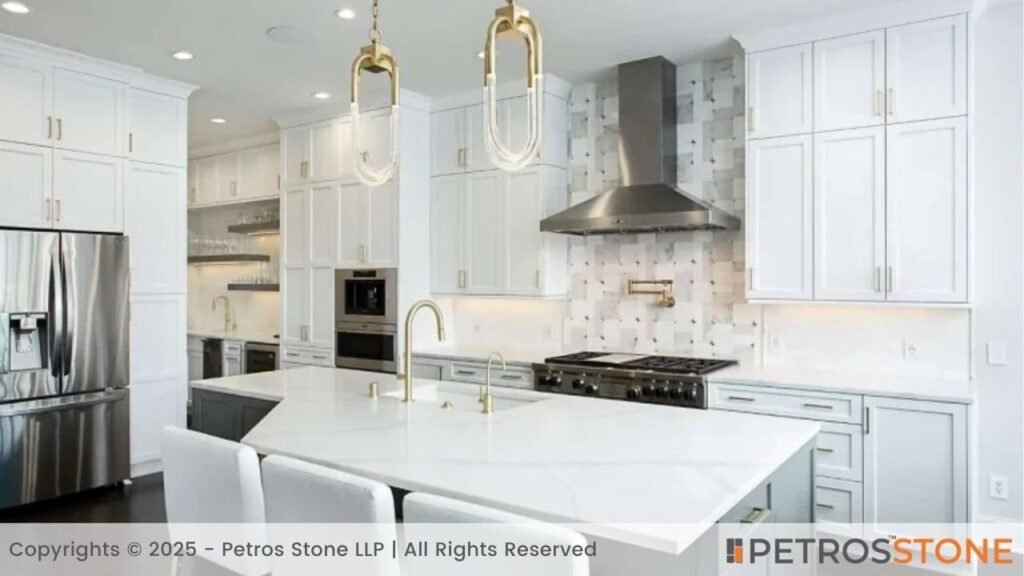

Backsplashes don’t endure the same level of stress as countertops, so thinner slabs are perfectly acceptable here. In fact, using a thinner cut reduces cost and weight while maintaining style.
- 2 cm Quartzite: A common choice for backsplashes, giving enough durability without unnecessary bulk.
- 1.2 – 1.5 cm Ultra-thin Slabs: These are sometimes used for full-height backsplashes that extend to the ceiling. Their lighter weight makes them easier to mount vertically.
- Bookmatched Quartzite slabs: Thin slabs (approx. 2 cm), when used for a dramatic statement wall behind a stove or sink, are stacked in a mirrored pattern to showcase the natural veining.
An additional consideration when installing a backsplash is if you would like just a standard 4-inch backsplash strip (cut from the countertop slab), or if you would like to have a full-height slab backsplash. A full-height slab backsplash looks fantastic in modern kitchens, especially in a modern industrial design with a waterfall island made of the same material.
Recommended Size & Thickness by Application
Quartzite isn’t a one-size-fits-all material. The right slab size and thickness depend a lot on where it will be used. For example, a kitchen island needs a different size and thickness than a shower wall or fireplace surround. Here is a useful guide to help you pick the best configuration for each use.
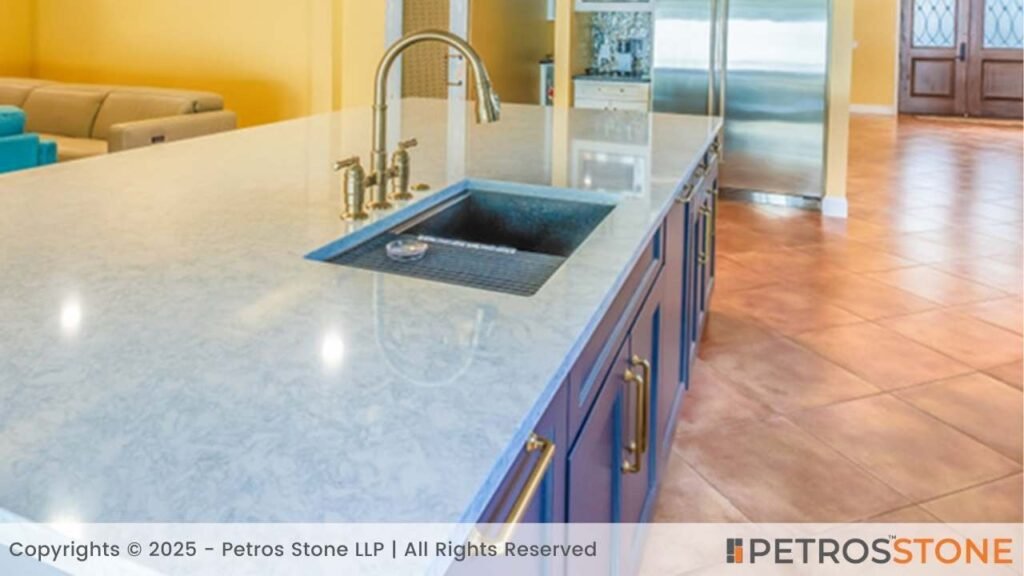
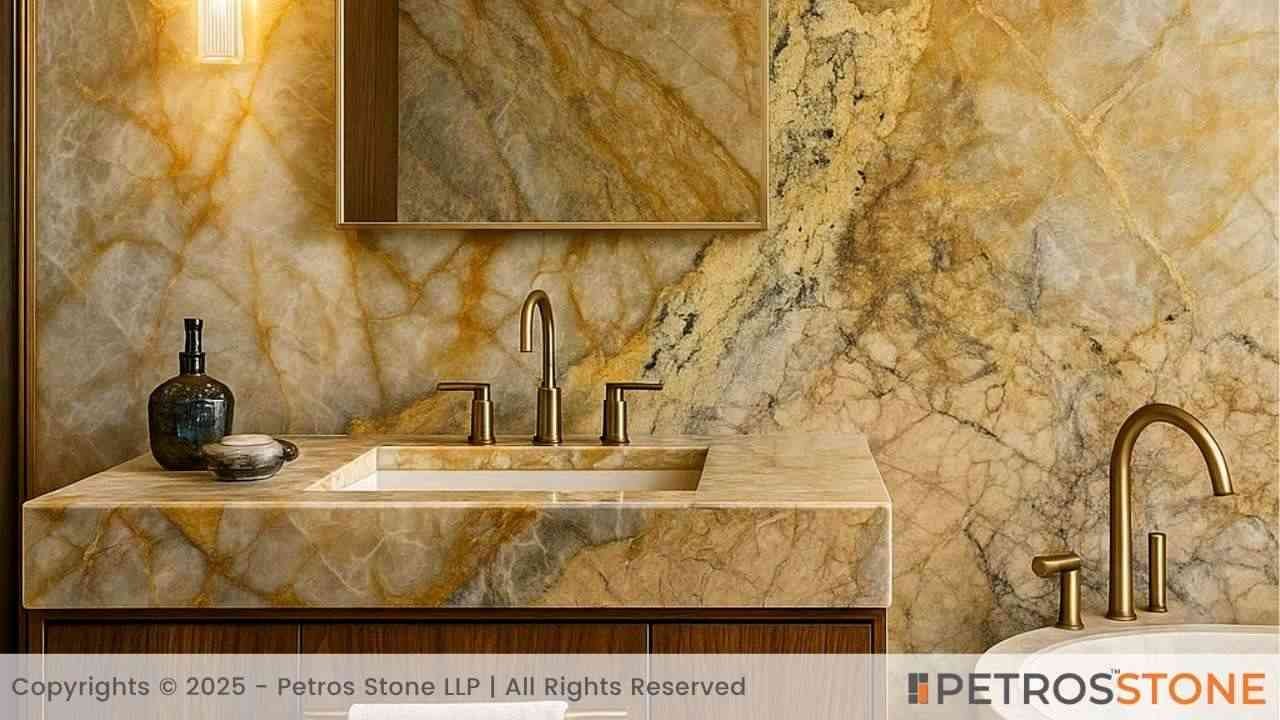
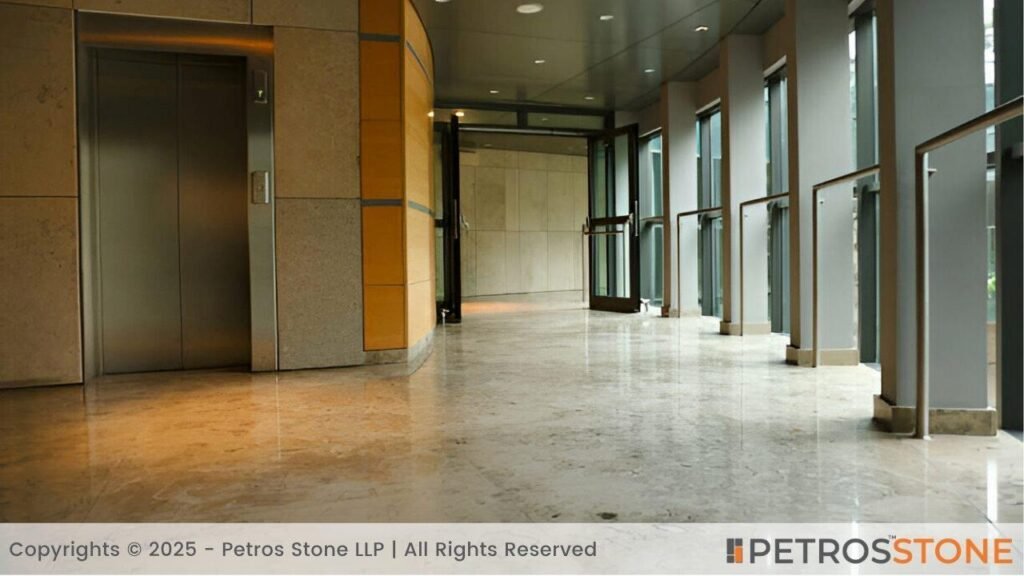
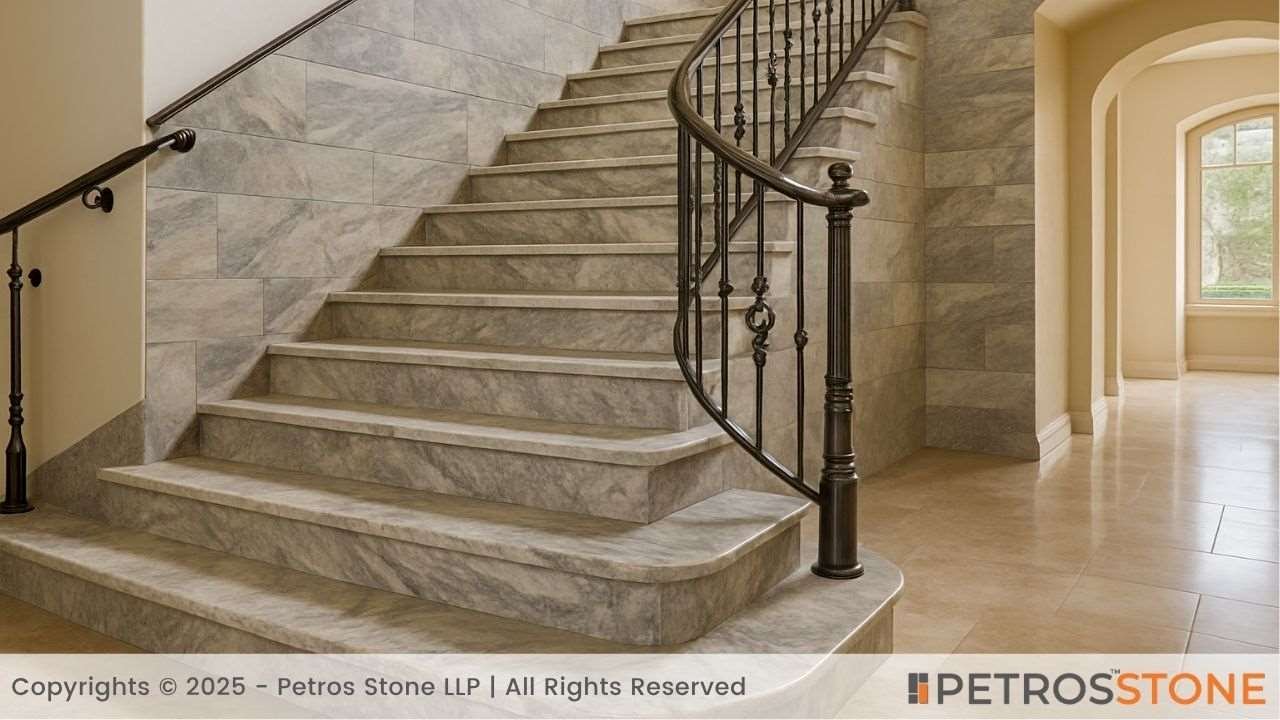

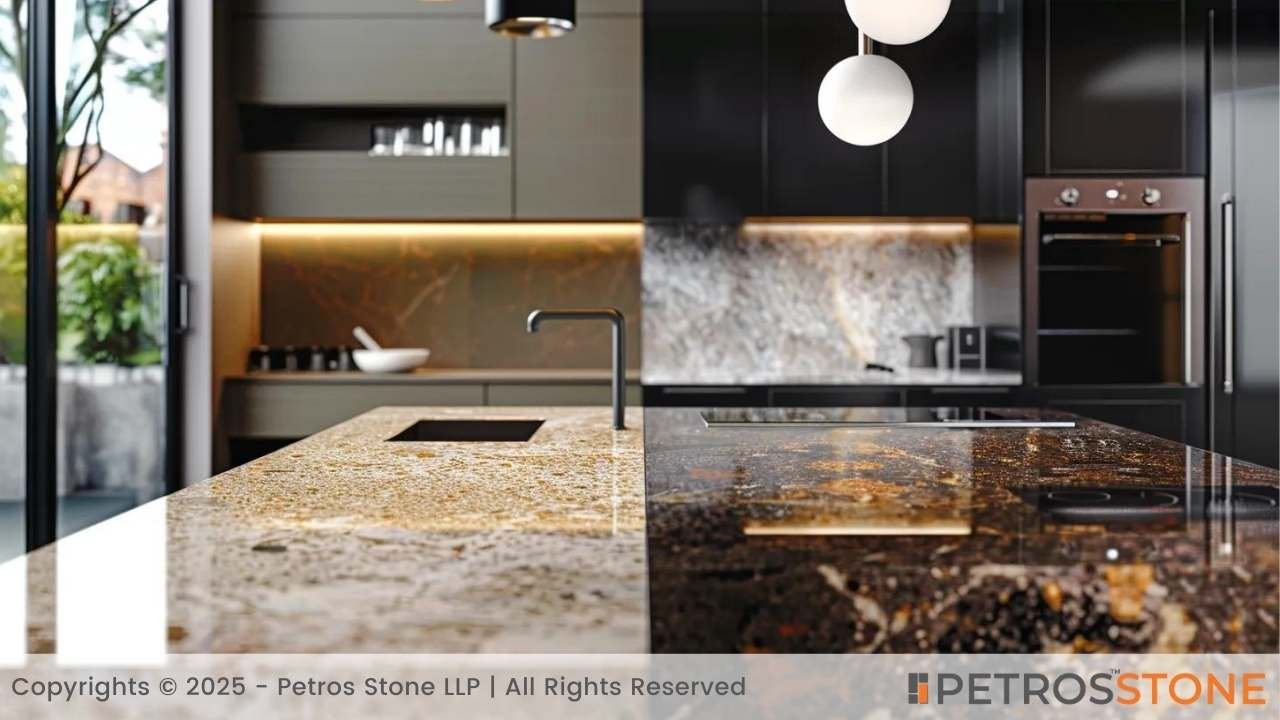
Table – 10 Applications with Ideal Size & Thickness
| Application | Recommended Slab Size | Ideal Thickness |
| Kitchen Countertops | Jumbo (126″ x 63″) | 3 cm |
| Kitchen Islands | Super Jumbo (138″ x 80″) | 3–4 cm |
| Bathroom Vanities | Mini or Jumbo (96″ x 55″ – 126″ x 63″) | 2 cm or 3 cm |
| Backsplashes (Standard) | Mini (96″ x 55″) | 2 cm |
| Backsplashes (Full-Height) | Jumbo or custom tall cut | 1.2–2 cm |
| Flooring (High-Traffic) | Custom cut (large rectangular tiles) | 2 cm |
| Fireplace Surrounds | Jumbo or custom | 2–3 cm |
| Outdoor Kitchens | Jumbo (weather-resistant cuts) | 3 cm |
| Stair Treads | Custom cut to tread size | 3 cm |
| Wall Cladding / Feature Walls | Jumbo or Super Jumbo | 1.2–2 cm |
If you are considering purchasing quartzite, it is important to source it from a reputable supplier. Petrosstone offers quartzite slabs in various thicknesses, sizes, and finishes, with great assurance. Their industry knowledge means you will have both beauty and durability, whether you need it for a fully functioning high-end kitchen, a gorgeous boutique hotel, or a sleek outdoor living space.
Standard Dimensions and Custom Cuts

Typically, slabs measure approximately 110 to 140 inches in length and 55 to 80 inches in height; however, variations in quarry production can lead to differences in sizes.
For large projects, custom cuts are an option. A 12-foot island may require one uninterrupted piece, or you may need oversized panels for a wall in a hotel lobby, and so on. Conversely, perhaps a small bathroom would benefit from narrower slabs to limit waste.
Custom Cutting and Edge Profiles
Thickness doesn’t just stop at the raw slab. Fabrication techniques allow quartzite to take on different profiles that enhance both performance and design.
Laminated Edges
Fabricators can join two slabs together at the edge, doubling the visible thickness. For example, a 2 cm slab with a laminated edge appears as 4 cm thick. This technique is common in luxury kitchens and reception counters where a bold, substantial look is desired without the full weight of a 4 cm slab.
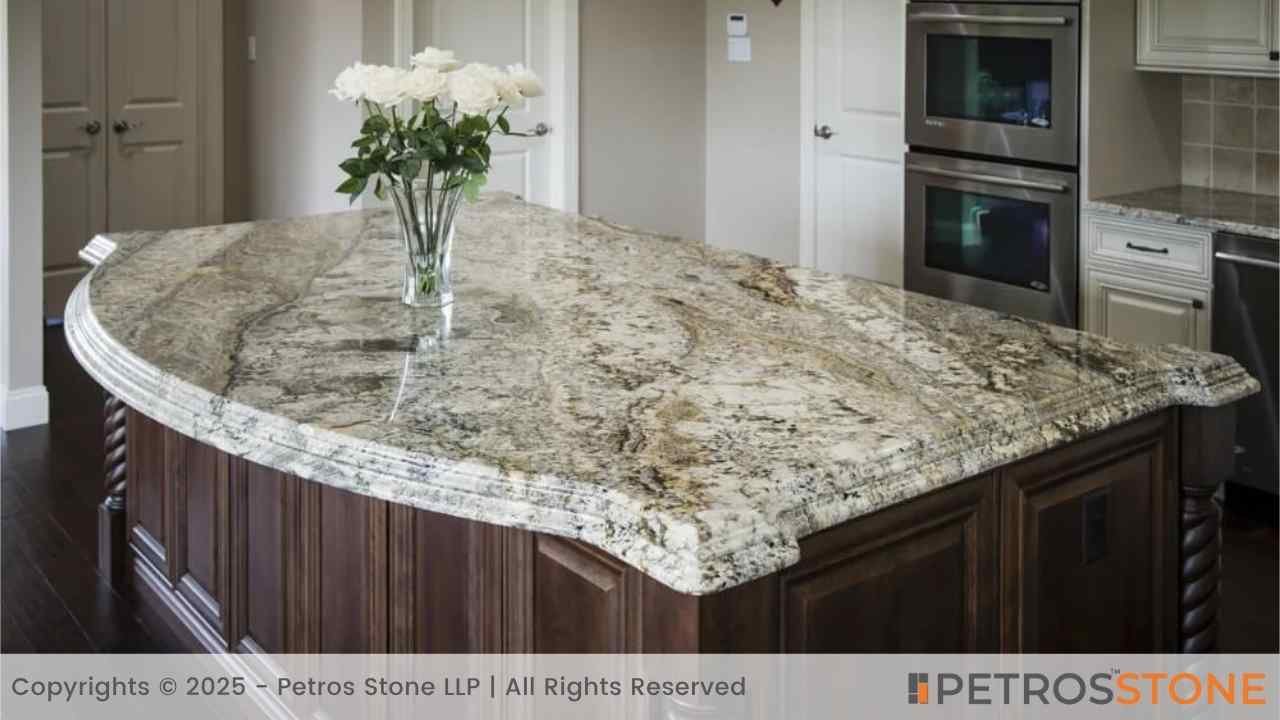
Mitered Edges
This involves cutting the edges of a slab at 45 degrees and joining them to create a seamless, waterfall-style finish. Mitered edges are popular for modern island designs and can make a countertop appear thicker than it actually is.
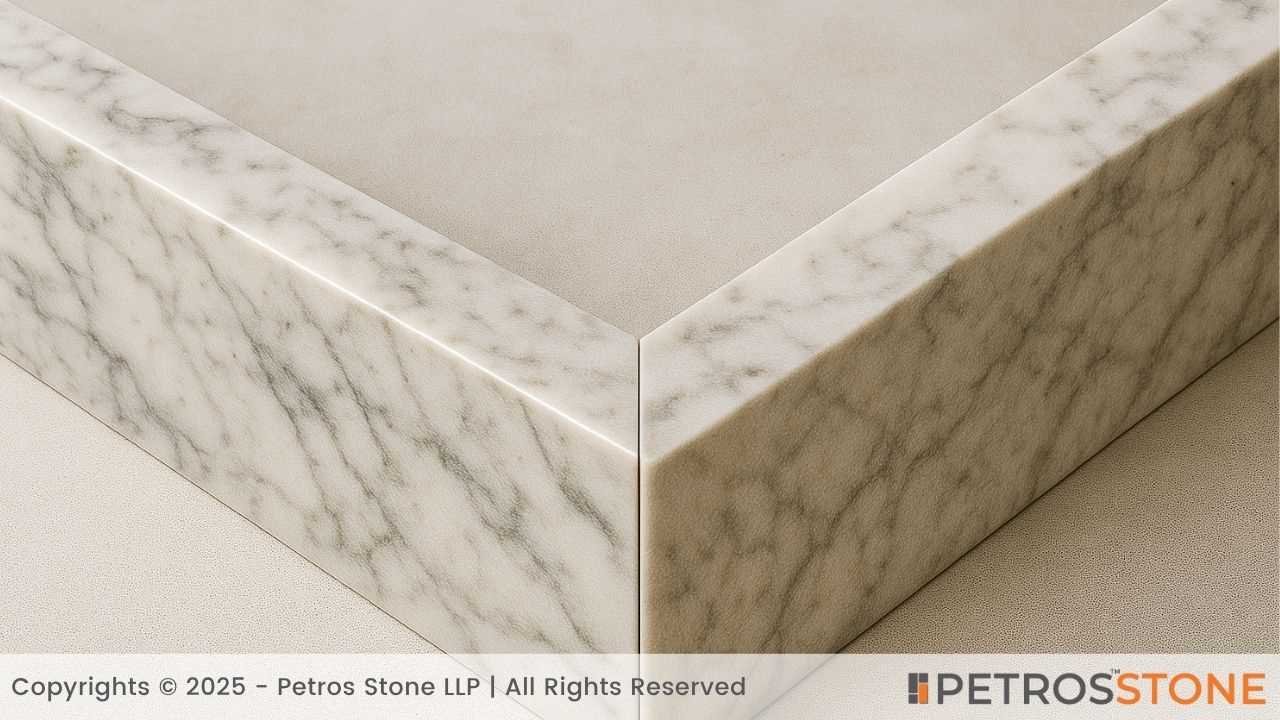
Ogee, Beveled, and Bullnose Edge Profiles
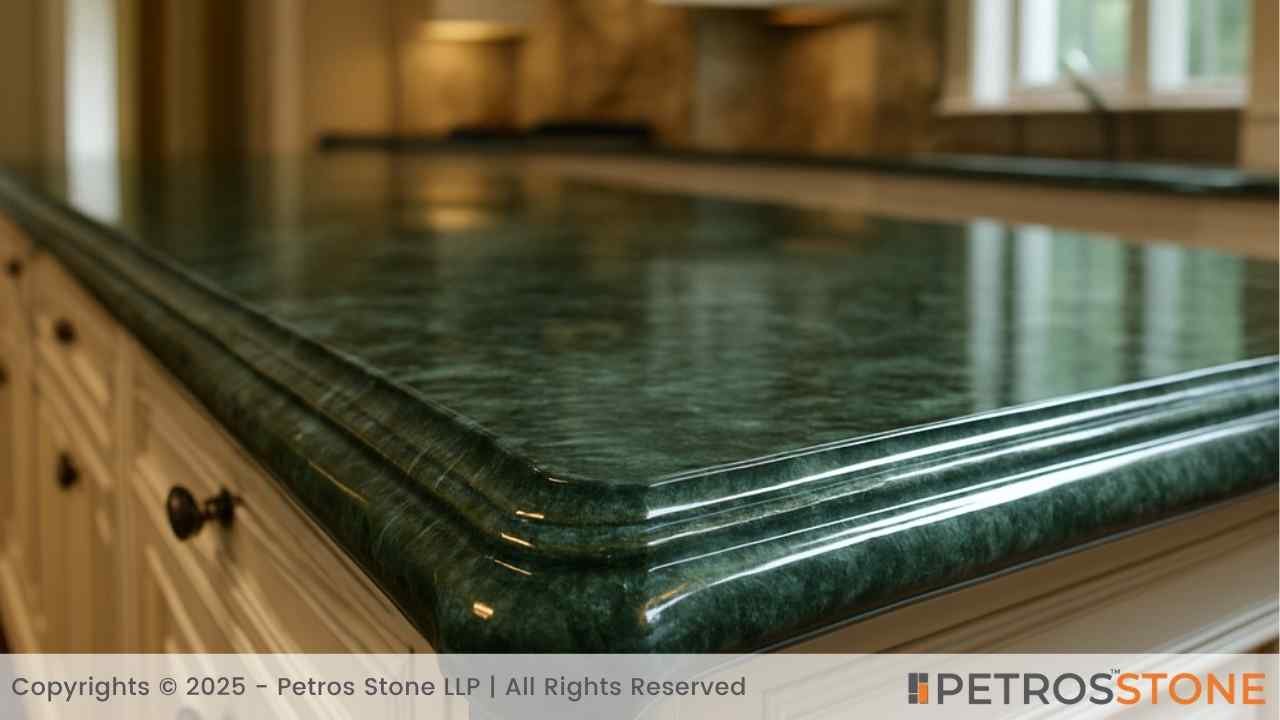
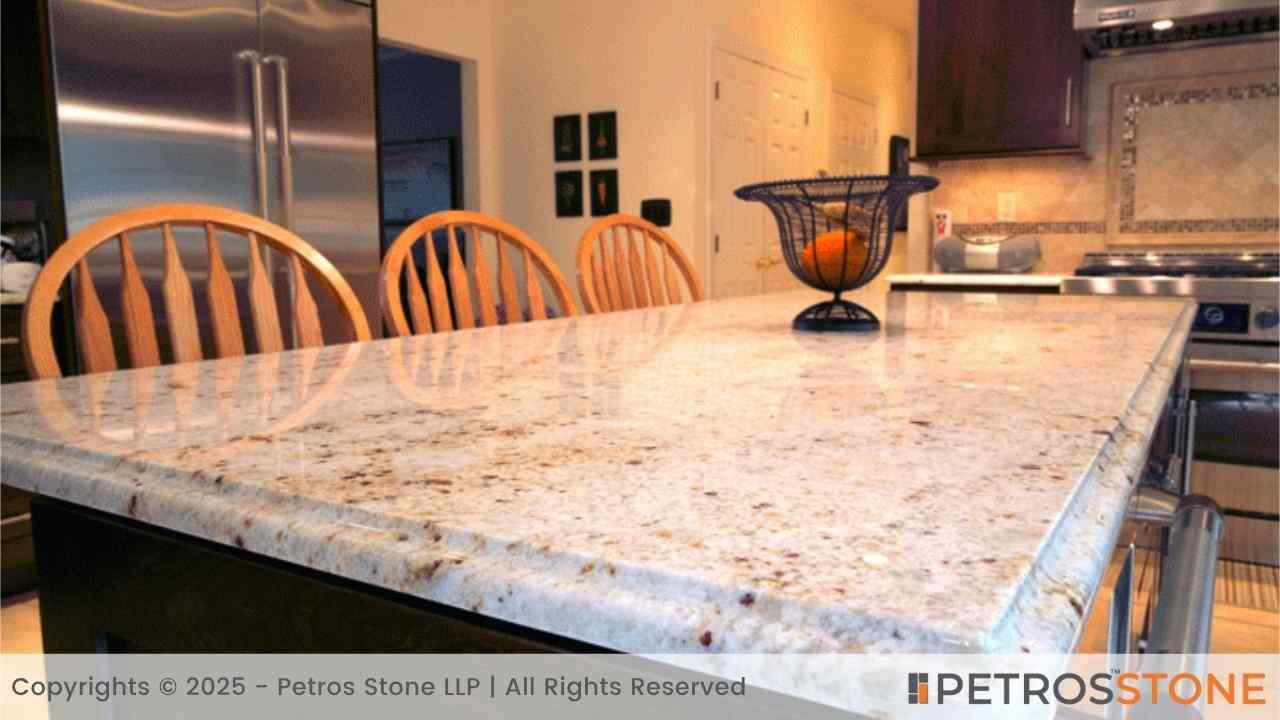
These are decorative edge finishes applied to both 2 cm and 3 cm slabs. They don’t change the actual thickness but alter the perception of depth and style. For instance, an ogee edge adds elegance, while a bullnose softens the look.
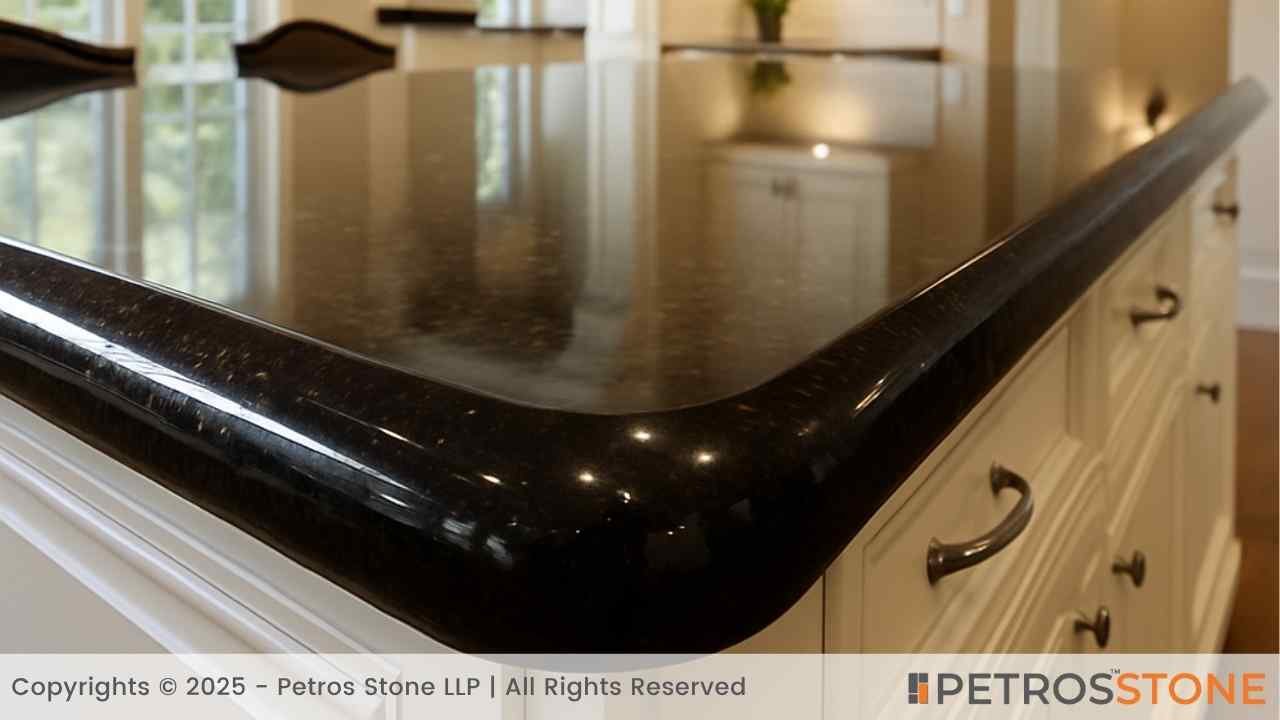
Bookmatching with Thin Cuts
This involves cutting the edges of a slab at 45 degrees and joining them to create a seamless, waterfall-style finish. Mitered edges are popular for modern island designs and can make a countertop appear thicker than it actually is.
These customization aspects allow quartzite slabs to be customized not only to meet the structural demands of the project but also to meet the project’s design language.
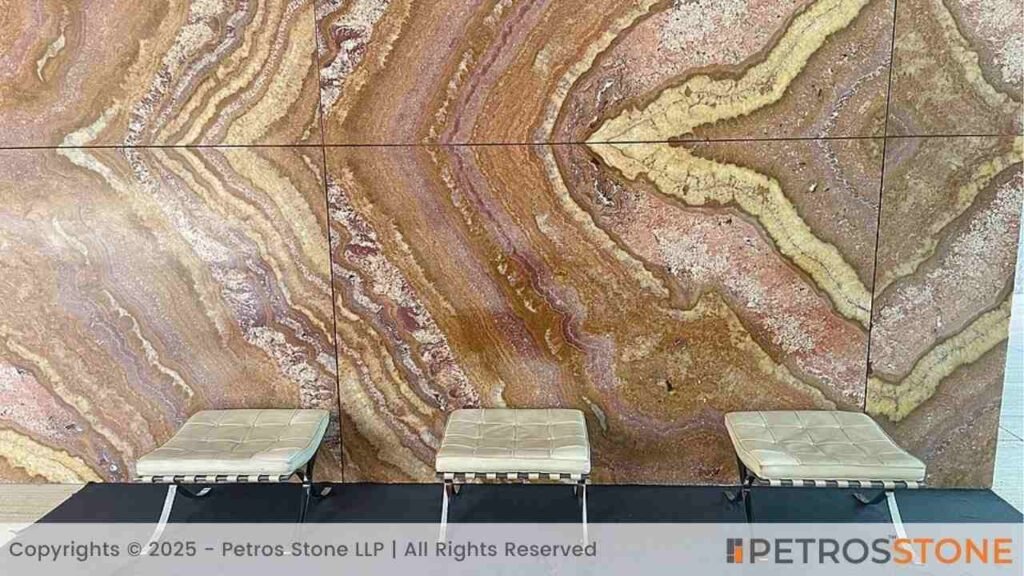
Physical Properties of Quartzite
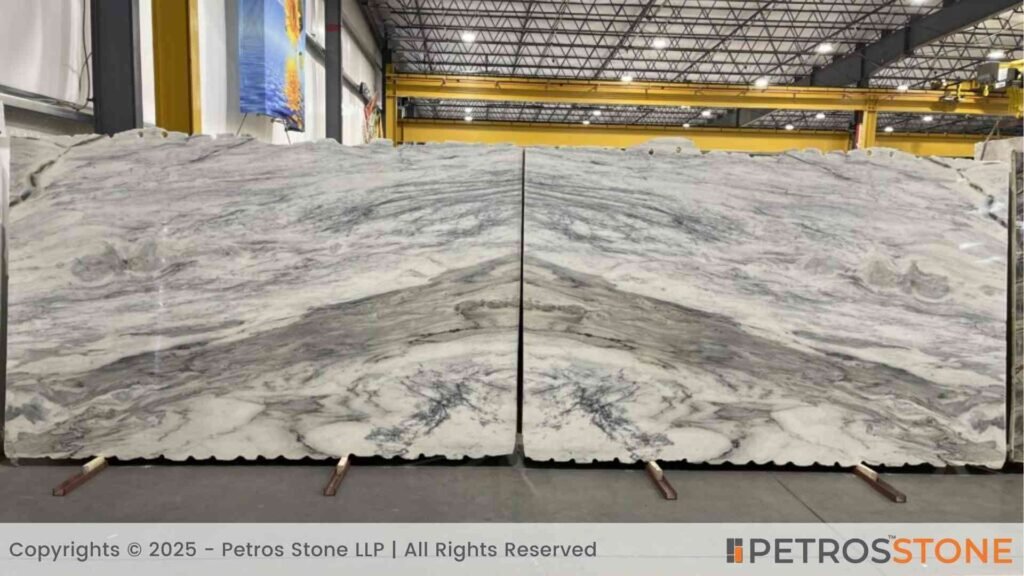
While granite and marble may sit next to quartzite, quartzite occupies its own position on the hardness, density, and durability spectrum. The following discussion about these properties will explain why quartzite deserves serious consideration in regard to high-traffic kitchens, exterior features, and architectural details that will last.
- Hardness: Quartzite demonstrates an approximate hardness of 7 on the Mohs hardness scale, which makes it much harder than marble (3-4) and comparable to granite (6-7).
- Density: In relation to sandstone, quartzite has a denser crystalline structure, meaning lower porosity. Some quartzites are porous enough that they will need to be sealed.
- Durability: Quartzites are scratch-resistant, highly heat-resistant, and resistant to most chemicals (except acidic spills similar to lemon juice that would etch lighter quartzite).
- Appearance: Quartzite often reminds us of the elegant veining characteristic of marble.
Table – Strength, Hardness, Durability & Other Properties
| Property | Quartzite Value / Range | Comparison / Notes |
| Mohs Hardness | ~7 (very hard) | Harder than marble (3–4), similar to granite. Resistant to knife scratches. |
| Density | 2.6 – 2.8 g/cm³ | Denser than many natural stones, it contributes to durability. |
| Compressive Strength | 150–300 MPa | Handles heavy loads, suitable for countertops and flooring. |
| Flexural Strength | 10–20 MPa | Higher than marble; withstands bending stresses better. |
| Water Absorption | 0.2 – 0.5% | Low porosity, but still benefits from sealing to prevent stains. |
| Abrasion Resistance | High | Excellent for flooring and outdoor use in high-traffic areas. |
| Heat Resistance | Very High | Can tolerate hot pans directly; less prone to thermal shock. |
| Chemical Resistance | Good (except strong acids) | Acidic liquids may etch polished surfaces; sealing reduces risk. |
| UV Resistance | Excellent | Color and structure remain stable under sunlight exposure. |
| Longevity | 20–30+ years with proper care | One of the most durable natural stone surfaces available. |
In practice, these properties mean quartzite can confidently be used not just indoors but also in patios, outdoor kitchens, and wall claddings exposed to weather. Few stones combine marble-like beauty with granite-level strength the way quartzite does.
FAQs
What is the average size of a quartzite slab?
Most slabs typically range from 110 to 140″ in length and 55″ to 80″ in height. Jumbo slabs are usually about 126″ x 63″, and super jumbos are even larger at 138″ x 80″.
What thickness is preferable for quartzite countertops?
3 cm slabs are preferable. The advantages are structural stability, no need for plywood support, and luxurious looks.
Can I use 2 cm quartzite slabs for countertops?
Yes, 2 cm quartzite can be used for countertops, but they typically require plywood backing or laminated edges to reinforce them. They are mostly used for vanities, backsplashes, or wall cladding.
Summary
Quartzite is a stunning, durable, and versatile natural stone. Your slab’s size and thickness will ensure that your horizontal surface will be both stunningly elegant and safe. This applies to a large kitchen island or a full-height backsplash, or even a stunning feature wall. So, if you appreciate the natural veining (the aesthetic of the stone), you can marvel at the history of our planet that quartzite showcases for potentially millions of years.
Key Takeaways
- Quartzite is a natural stone formed from compression and heat, but it also has visual beauty and structural integrity.
- Every slab is colored and patterned differently based on its geological origin.
- The size and thickness are critical for design, costs, and installation time.
- There are slab sizes like mini slabs measuring 8 × 4.5 ft. or super jumbo-sized slabs measuring 11.5 × 6.6 ft.
- Standard thicknesses are 2 cm (light, versatile, has to be supported) and 3 cm (heavy, solid for countertop use), although custom sizes are available.
Feel free to get in touch for a free consultation, quote, and get a detailed understanding from our experts here at Petros®. Visit https://petrosstone.com/ or call +91-8446360361 and WhatsApp

Hi, I’m Dhananjay,
With a background in architecture and years of industry experience, I share insights on materials that shape great design. At Petros® Stone, I craft content that highlights the beauty and utility of natural stone, helping architects, builders, and homeowners make informed choices while strengthening the brand’s voice and online presence.
Brown Granite
White Galaxy Granite
Blue Bahia Granite
Silver Cloud Granite
Black Pearl Granite
Dallas White Granite


